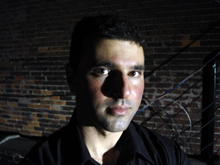John Farah
By wavelength ~ Posted Sunday, April 1st 2007
WL 357 - Sunday, April 1 – 11pm
Purveyor of: “everything and nothing”
Even more so than most Wavelength acts, John Farah’s music defies description; which makes this paragraph sort of... tricky. His music is electronic, but it ventures far beyond the typical drum’n bass party beats to express classical influences, free jazz, Arabic scales, and more. To tell the truth, Evan Dickson can’t make heads nor tales of it, so he turned to John himself for some answers.
Do you ever consider the political metaphors that might arise from incorporating Western and Middle Eastern traditional influences in your music?
I could share one person's take on this which I found interesting. After playing a set at the Trane Studio, an Iranian woman told me that she found the emotions conjured up very disturbing; the calmer, reflective parts were like warm memories of home from childhood and the region's history, and the more aggressive electronic elements were like bullet fire, tanks, oppression (military, cultural and psychological), resistance, tearing apart that fragile tranquility. But the middle-eastern element in my music is only an occasional thing, and when it is an element, I think of it as coming from a place of unity, not conflict. In the ancient world right up until the middle-ages, they were part of the same broader civilization, they had the same roots. In Greek mythology, Zeus seduced and abducted Europa, princess of Phoenicia; this is where Europe gets its name; there weren't the same dividing lines as today, that's my frame of mind.
Does working from such a unique blend of influences make it difficult for you to get gigs or sell albums? What do you say when people ask you, “What do you sound like?”
I think these days a lot of musicians have to deal with this, it's a little easier if your music fits cleanly in one genre, or several closely related genres. I think that those who are into it are random people from here and there who are in the same headspace as me, so my music is not aimed at any particular audience or venue. It's very hard to describe, it's much easier to talk about it with someone once they've seen me perform. What I love are the Promise Chamber Events, where an opera singer performs right after an ambient electronic guy, followed by something experimental, then a DJ, etc.... I think it would be great for everybody if there were more events like these. When people ask what I sound like, my ideal answer is “Everything and Nothing.” try to stay away from naming genres and using words like 'fusion', but I always end up using it in the end; it's the easiest reference, but it's misleading. Its not about playing in different styles or just throwing things into a mix. Messiaen, Schoenberg and Cage showed me that although anything can be used as musical material; what's crucial is integrating into the bigger picture, the artistic whole. Most musical and artistic instruments, ideas, forms, etc are mutations or reactions to earlier ones, and the further back you go, the larger your frame of reference, the more futile all the countless genres and sub-genres seem.
You’re an artist as well as a musician. How does working in different disciplines affect your music?
In both art and music I try to capture continuous unfolding of energy (you could say energy or spirit or emotion or whatever). Both sides learn from each other. Sometimes I can be much more uninhibited and freely creative in my art. When making music, unless you're doing pure improvisation, usually there are all these technical concerns and variables you can get caught up in that can possibly inhibit the creative flow, so I try to use my art as an example for when I compose or improvise. Sometimes I bounce back and forth between the two, sometimes I only focus on one for a while. This can make short-term progress slower, but I think it’s more important to me in the long run.
To what degree is your music improvised?
It depends on the context of the show. There's always improvisation, it's just a matter of how much. Recently my set is more structured, like a skeleton to be fleshed out with improvisation, this ensures the set has direction and momentum and freedom at the same time. Some events (like piano concerts I used to put on myself or AIMT Leftover Daylight series) have a condusive atmosphere to purely improvised music, but at other times I prefer to have things mapped out loosely. My current live set alternates between improvising along with pre-composed electronic textures and freely improvised sections (like the balance between negative and positive space in a painting); the interplay of improvisation and composition unifies the overall structure of the set.
You have also been the artist in residence at Trane Studio jazz club on Bathurst. Tell people how great that place is, cuz businesses in that Bathurst hood often struggle.
Trane Studio's atmosphere is unique in Toronto, it's a breath of fresh air, and I think a lot of Wavelength musicians and audience would dig it. There's a decent sound system and even a projector and screen if your show has visuals. All sorts of great musicians play there, and I appreciated them showcasing my visual art. It's sort of a half-gallery, with the artwork given more prominence than a cafe with art on the walls. It's just north of Bathurst and Bloor.
This isn't your first Wavelength set, is it? How have things changed since the last time you played a WL?
Yeah that was a few years ago. For the longest time I was just absorbing everything I could possibly take in and letting it sort out in my head. I still do that, but for the last while I've focused on tightening and unifying.
